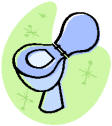| Common problem | What you can and cannot do | |
| When to declare a provisional ball |
 |
If you believe that your ball may be lost outside of a penalty area (or may be out of bounds), you can declare and play a provision ball (Rule 18.2). The rules state that either a ball is in penalty area or it isn't - there is no 'maybe' - and so a provisional ball cannot be declared in this case. Unless there is a local Rule (there is at Heydon) you cannot declare a provisional ball if you believe that the ball is in a penalty area. |
| How to declare a provisional ball |
 |
Before making the stroke You MUST use the word “provisional” or otherwise clearly indicate that you are playing the ball provisionally under Rule 18.3. In the rare occasion where they are not nearby, you must inform them as soon as possible. |
| One club length or two? |
 |
People often forget whether relief involves one club length or two. The easiest way the remember is that free relief = 1 club length. A penalty shot buys you an extra club length. You must use the longest club in your bag to measure the relief area. |
| My ball is buried in a gorse bush (Rule 19) |
 |
A player
is the only person who may decide to treat his or her ball as
unplayable by taking penalty relief under Rule 19.2 or 19.3.
Unplayable ball relief is allowed anywhere on the course, except
in a penalty area. If you
find your ball in a gorse bush (eg on Essex 3rd), you have four
options:
|
| Ball hit with practice swing off the green |
 |
If you take a practice swing and accidentally hit the ball, you must replace the ball under penalty of one shot. (Playing on without replacing it incurs a two-shot penalty in stroke-play or loss of hole in match-play.) However, if you were taking a tee shot - hitting the ball accidentally incurs no penalty and the ball must be replaced. The reason for the difference is that on the tee, the ball is not yet in play. . On the green, the ball must be replaced without penalty. |
| Ball in a yellow staked penalty area |
|
The pond
in front of the Essex 1st green is a yellow staked penalty area. You
have three options (Rule 17.1):
|
| Ball in a red staked penalty area |
|
The pond
to the right of the Essex 9th green is a red staked penalty area. These are treated the
same as yellow staked hazards except that dropping behind the
hazard would be impractical. The options you have (Rule 17.1)
are the same as for yellow stakes except that you have one
further option:
|
| Staked, netted trees etc |
 |
In the normal rules, free relief can be obtained from staked trees. At Heydon, free relief can also be obtained from small trees where they have been marked with netting, tags or a protective sheath around the trunk. The last point is especially important because there are many trees with light green plastic sheathing on them - particularly in the plantation areas. |
| Relief from animal holes |
 |
This rule covers free relief that is allowed from interference by animal holes, ground under repair, immovable obstructions or temporary water (including badgers, rabbits, moles and ants) anywhere on the course'. Except where your ball lies in a penalty area, you may get relief without penalty (drop within 1 club length of your nearest point of relief no nearer the hole). |
| Un-playable ball (Rule 19) |
 |
Anywhere
on the course (except in a penalty area), you can declare your
ball unplayable - even if it is sitting in the middle of the
fairway! Your options (under a 1 shot penalty) are:
However, if your ball is in a bunker, under (1) or (2) you must drop it within the bunker for a 1 shot penalty or outside for a 2 shot penalty (Rule 19.3). |
| Nearest point of complete relief. Rules 16, 13 and 17. |
 |
There is much confusion about what is your 'nearest point of relief'. Put simply, it is the closest point where you would place your ball such that your stance and intended swing is no longer affected by whatever you were taking relief from (eg an animal hole or staked tree). It is NOT the nearest place from where you can easily hit the ball. In some cases, your nearest point of relief might be in deep rough or a bush!!! |
| So many obstructions! |
 |
An
obstruction is anything artificial such as a roadway, hut,
distance marker, yellow/red stake, bin, ball washer etc. An
obstruction is 'movable' if you can move it (!) - without
unreasonable effort/delay or causing damage to it or yourself.
Procedure here (Rule 16.1) is to move the obstruction (replacing
the ball if it moves in the process) and taking your shot
without penalty. Should the Sphinx appear on the Cambs, this would be an immovable obstruction (Rule 24.2), from which you can take a free drop within one club length from your nearest point of relief no nearer the hole - except if you are in a penalty area. |
| Planter box on the Essex 4th |
 |
The planter box and adjoining path is
in a “Yellow Penalty” area. You can no longer get free
relief if your ball lands in it or up against it or rests on the
adjoining pathway. Your reference point for taking relief
is back on line with where the ball crossed into the penalty
area and the flag; the relief area is one "longest" club length
from the reference point. |
| Tending the flag |
|
You can have the flag tended at any time even if you are teeing off on a par 5 although this might make you unpopular! But only if it does not delay play. |
| Tyre tracks |
 |
Tyre tracks anywhere on the course made by tractors, motorcycles, buggies and tanks are 'ground under repair' and hence are treated as abnormal course conditions (except in hazards). You may take a free drop one club length from your nearest point of relief no nearer the hole. |
| Completing competition cards |
|
No matter
what the competition format (stroke play, stableford, bogey
etc), you only have to do a few simple things before putting
your completed card in the competitions box:
Everything else is the responsibility of the competitions committee - adding up, calculating stableford points, applying handicap formulas (eg 7/8ths) |
| Wrong handicap |
|
About once per month, at least one person declares the wrong handicap on their competition scorecard - please ensure that next time, it isn't you! Make a habit of checking the official handicap list before you submit your card. If you declare a handicap lower than your true handicap, the card is processed as if the lower value were your correct one. If you declare a higher handicap, you are disqualified if it affects the number of shots received. (In practice, you would always be DQ'd in a stroke play event or a stableford competition off full handicap. However, if you were in a stableford competition off 7/8 hcp and it just so happened that 7/8ths of your true handicap were equal to 7/8ths of your declared handicap, you would not be DQ'd). |
| Searching for balls.
Rule 7.1a |
 |
Only 3
minutes is allowed. If you agree that time is up, it really is
!! If you then find your ball (eg when walking back to play
another) then tough - you must continue to take another as the
first is deemed lost. If your partner finds your ball before the
3 minutes is up. You do have reasonable time to go to your
partner and identify it.. There is no penalty if the ball is accidently moved in searching. But it must be replaced in its original location in an identical condition. A small part of the ball can be visible if buried. |
| Ball moves on the green Rule 9.3 |
 |
If the wind or gravity moves your ball on the green (before you have marked it), you must play the ball as it lies without penalty. . Rule 9.3. If the ball moves after you have marked it, it must be replaced on its original spot or as near as you can estimate.There is no penalty when the player accidentally causes the ball to move on the putting green (Rule 13.1d), no matter how that happens. |
| Frost on the putting surface |
 |
Heydon
may be one of the few places where we can play nearly all year
round, but the winter brings its own special challenges. Snow
and natural ice (other than frost) are either loose impediments
or, when on the ground, temporary water, at the player's option.
Dew, frost and water are not loose impediments. If there is frost on the green, you cannot remove it - either in the vicinity of your ball or from the line of your putt. What about those big chunks of ice which fall off our shoes onto the green? The rules do allow you to remove them or to remove frost if it is incidental to removing loose impediments such as small stones, small lumps of loose soil/sand or detached grass. Provided that these chunks include such loose impediments - as most of them will - then they can be safely removed. What you cannot do is just brush away frost along your line of putt. Sand and Loose Soil are not loose impediments off the green. i.e. the general area – including the fringe of the green, and cannot be moved without penalty. |



